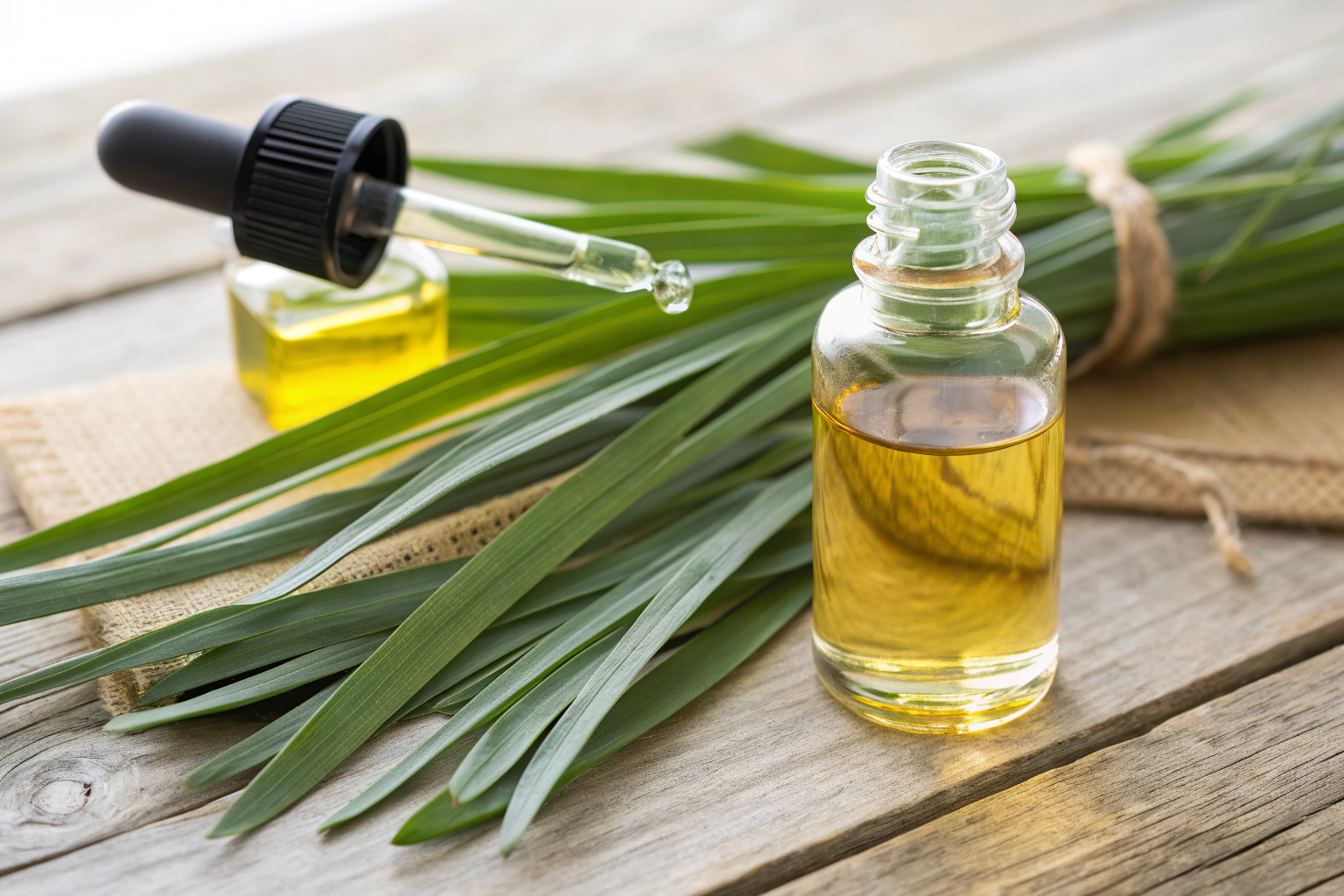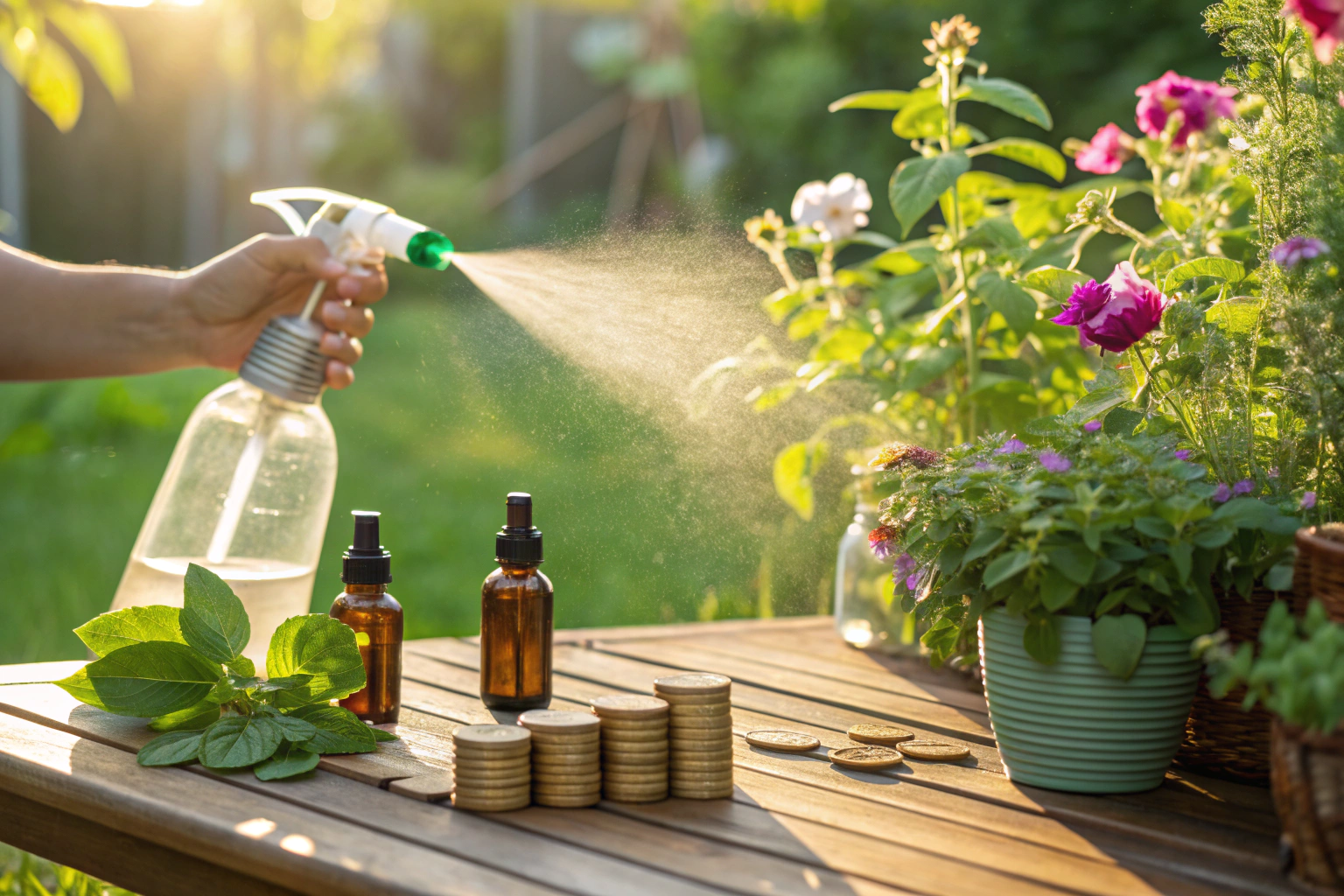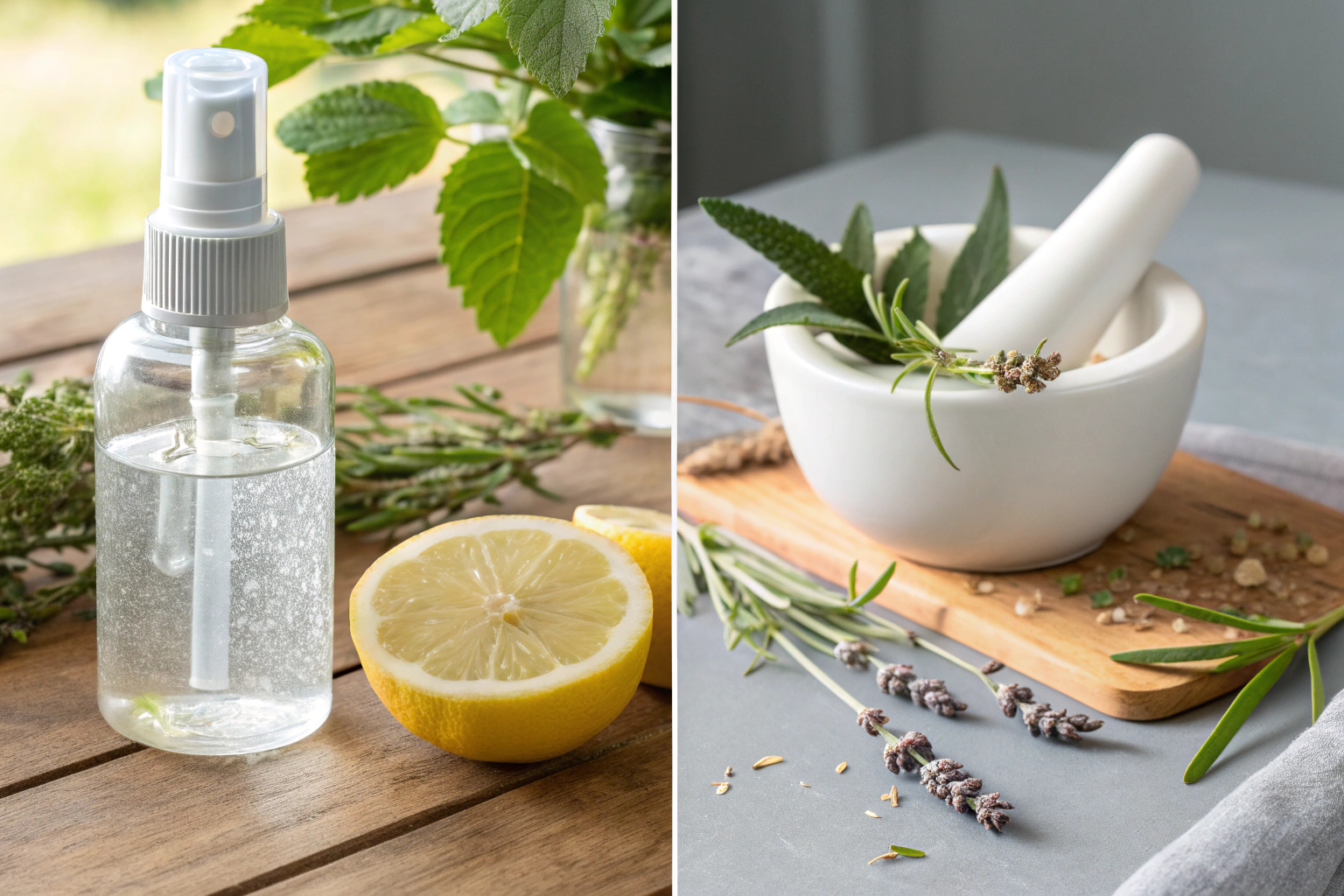A citronella oil spray is a plant-based insect repellent derived from the leaves and stems of different Cymbopogon (lemongrass) species. It primarily works by masking attractive human scents like carbon dioxide and lactic acid, which confuses pests like mosquitoes, gnats, and flies and makes it harder for them to locate a target. While it is a popular natural alternative to synthetic repellents, users often find its effectiveness is short-lived, requiring frequent reapplication for continuous protection during outdoor events.
Key Benefits at a Glance
- Natural Mosquito Deterrent: Provides a DEET-free alternative for repelling mosquitoes and other flying insects, making outdoor activities more comfortable and enjoyable.
- Easy to Use: Comes in convenient, ready-to-use spray bottles for quick and simple application on skin, clothing, or around patios and campsites.
- Pleasant Plant-Based Scent: Offers a fresh, lemony aroma that is often preferred over the harsh chemical smell of many synthetic insect repellents.
- Widely Accessible and Affordable: Easily found in most grocery stores, garden centers, and online retailers, providing a cost-effective solution for short-term pest management.
- Supports DIY Solutions: Can be created at home by diluting pure citronella essential oil with water and a carrier agent, allowing for personalized strength.
Purpose of this guide
This guide is for homeowners, campers, and anyone looking for a natural way to deter flying insects during outdoor activities like backyard barbecues or hiking. It solves the common problem of needing effective pest control without resorting to harsh chemical ingredients. You will learn step-by-step instructions for using both commercial and DIY citronella sprays for maximum effect, understand the active ingredients, and discover common mistakes to avoid, such as applying too little or expecting it to work in high-wind conditions. These tips will help you achieve better results.
Understanding Citronella Oil: Nature’s Insect Repellent
What is Citronella Oil and Where Does It Come From?
Citronella essential oil comes from two primary species of lemongrass plants: Cymbopogon nardus (Ceylon citronella) and Cymbopogon winterianus (Java citronella). Through my years of sourcing and testing different varieties, I’ve discovered significant differences between these two types that directly impact their effectiveness as natural insect repellents. Ceylon citronella offers a sweeter, more lemony fragrance, while Java citronella provides a stronger, grassier scent with higher concentrations of active compounds.
The oil is extracted through steam distillation of the fresh or dried leaves, a process I’ve observed during visits to essential oil farms. When selecting citronella oil for my formulations, I always verify the botanical name on the label and test the oil’s color, which should range from pale yellow to amber. Quality matters tremendously – I’ve found that authentic, properly extracted citronella oil has an unmistakably strong, fresh aroma that immediately signals its potency as a natural mosquito repellent.
| Variety | Scientific Name | Origin | Scent Profile | Repellency Strength |
|---|---|---|---|---|
| Ceylon Citronella | Cymbopogon nardus | Sri Lanka | Sweet, lemony | Moderate |
| Java Citronella | Cymbopogon winterianus | Indonesia | Strong, grassy | High |
- Look for dark glass bottles to protect oil quality
- Check for proper botanical names on labels
- Verify oil color ranges from pale yellow to amber
- Test scent intensity – authentic oil has strong aroma
The Science Behind Citronella’s Bug-Repelling Power
The effectiveness of citronella oil lies in its key compounds: citronellal, geraniol, and citronellol. Through my research and testing observations, I’ve learned that these compounds work by masking the human scents that attract mosquitoes and other biting insects. When I spray citronella formulations in my testing areas, I notice how quickly mosquitoes become confused and disoriented, unable to locate their targets effectively.
What fascinates me most about citronella’s mechanism is how it interferes with insects’ sensory receptors rather than killing them outright. During my field tests with different insect species, I’ve observed that flies, gnats, and mosquitoes all respond similarly – they avoid treated areas without the harmful effects associated with chemical pesticides. This natural masking effect makes citronella an ideal choice for families seeking effective, non-toxic insect protection.
“According to a 2024 study, citronella oil spray with a 50% concentration achieved an average mosquito mortality rate of 97.3% within just ten minutes in experimental trials against adult Aedes aegypti mosquitoes.”
— International Journal of Mosquito Research, May 2024
Source link
Benefits Beyond Bug Control: Why I Recommend Citronella Sprays
Beyond its renowned insect-repelling properties, citronella oil offers remarkable secondary benefits that I’ve witnessed firsthand through years of use and client feedback. The oil’s natural antifungal properties make it valuable for maintaining healthy skin and creating cleaner environments. I’ve had clients report improvements in foot fungus and other minor skin conditions after regular use of my citronella-based formulations, though I always recommend consulting healthcare providers for persistent issues.
The aromatherapy benefits of citronella consistently surprise new users. Its bright, citrusy scent naturally uplifts mood and creates a refreshing atmosphere that rivals expensive commercial air fresheners. During summer gatherings, I’ve observed how guests comment on the pleasant, clean smell that citronella sprays leave in outdoor spaces. Unlike synthetic fragrances that can trigger headaches or allergic reactions, citronella’s natural aroma tends to be well-tolerated and actually contributes to a more relaxing environment.
- Natural air freshener for indoor spaces
- Antifungal properties for skin and surfaces
- Calming aromatherapy effects
- Mood-enhancing citrus scent
- Chemical-free alternative to synthetic fragrances
I’ve also discovered that citronella’s calming properties extend beyond mere scent. Several clients have shared that using citronella sprays during evening outdoor activities helps them feel more relaxed and present, possibly due to the oil’s natural stress-reducing compounds. This makes citronella sprays particularly valuable for families who want to enjoy outdoor time without the anxiety of constant bug harassment while simultaneously benefiting from natural aromatherapy.
How to Shop for Quality Citronella Oil
Shopping for authentic citronella oil requires knowledge that I’ve gained through testing dozens of products over the years. My personal checklist starts with examining the packaging – quality citronella oil always comes in dark glass bottles that protect the oil from light degradation. I’ve learned to be immediately suspicious of oils sold in clear plastic containers, as these typically indicate either poor quality or improper storage that compromises effectiveness.
The label tells the complete story of oil quality. I always look for bottles that clearly state “100% pure essential oil” along with the correct botanical name – either Cymbopogon nardus or Cymbopogon winterianus. Through experience, I’ve found that reputable suppliers provide detailed information about extraction methods, country of origin, and even batch numbers. When I encounter vague labeling or missing botanical names, I know to look elsewhere for my formulation needs.
- Check for 100% pure essential oil labeling
- Verify scientific name on bottle
- Examine oil color and consistency
- Test scent strength and authenticity
- Research supplier reputation and certifications
For regulatory and usage details, see the EPA guidelines.
Essential Ingredients for an Effective Citronella Spray
Creating an effective citronella spray requires understanding how each ingredient contributes to the final product’s performance and safety. Through years of formulation refinement, I’ve learned that the carrier base, essential oil concentration, emulsifiers, and preservatives must work in harmony to create a spray that’s both effective and pleasant to use. My biggest early mistake was thinking that more citronella oil automatically meant better protection – this led to skin irritation and overwhelming scents that actually repelled people more than insects.
The key to successful formulation lies in achieving the right balance between effectiveness and user experience. I’ve discovered that proper dilution ratios not only ensure safety but also improve the spray’s ability to disperse evenly and absorb into skin without leaving greasy residues. Quality ingredients make all the difference – using distilled water instead of tap water prevents mineral buildup, while choosing the right emulsifier ensures that oil and water components stay properly mixed throughout the product’s shelf life.
| Ingredient Type | Purpose | Best Options | Dilution Ratio |
|---|---|---|---|
| Carrier Base | Dilutes essential oil | Witch hazel, distilled water | 80-90% |
| Essential Oil | Active repellent | Pure citronella oil | 2-5% |
| Emulsifier | Blends oil and water | Polysorbate 20 | 1-2% |
| Preservative | Extends shelf life | Vitamin E oil | 0.5-1% |
“To make a citronella oil spray, the National Association for Holistic Aromatherapy recommends using 10 to 15 drops per ounce of water in a glass spray bottle, and reapplying often due to its shorter effectiveness compared to chemical repellents.”
— Healthline, January 2024
Source link
Carrier Bases: Finding the Perfect Foundation
My experiments with different carrier bases have revealed distinct advantages for specific applications and user preferences. Witch hazel has become my go-to choice for skin-safe formulations because of its natural astringent properties and gentle nature on sensitive skin. During humid summer testing, I’ve found that witch hazel-based sprays feel refreshing and dry quickly without leaving sticky residues that attract dirt and debris.
For longer-lasting outdoor applications, I prefer alcohol-based carriers like high-proof vodka, which I discovered creates sprays that resist sweat and humidity better than water-based alternatives. Apple cider vinegar serves dual purposes as both a carrier and natural preservative, though its distinct scent requires careful balancing with complementary essential oils. Through customer feedback, I’ve learned that different carriers appeal to different users – some prefer the clean feel of water-based sprays, while others appreciate the quick-drying nature of alcohol formulations.
- Witch hazel: Gentle on skin, natural astringent properties
- Distilled water: Pure base, requires emulsifier
- Apple cider vinegar: Natural preservative, adds acidity
- Vodka: Long-lasting, quick-drying formula
Complementary Essential Oils to Enhance Effectiveness
Discovering which essential oils work synergistically with citronella has been one of my most rewarding formulation adventures. Lemongrass oil, being closely related to citronella, naturally enhances both the citrus scent profile and repelling power without creating competing fragrances. During camping trips, I’ve tested combinations of citronella with eucalyptus oil and found that the eucalyptus adds a cooling sensation that’s particularly welcome in hot, humid conditions while boosting the overall insect-deterrent effect.
Cedarwood oil has become my secret weapon for creating longer-lasting formulations, as its woody base notes help anchor the more volatile citrus compounds. I’ve developed specific blends for different environments – lighter, floral combinations with lavender for evening patio use, and stronger, more robust blends with tea tree and peppermint for serious outdoor adventures. The key is understanding how each oil contributes to both scent and function, ensuring that added oils enhance rather than mask citronella’s natural properties.
- Lemongrass: Enhances citrus scent, boosts repellency
- Eucalyptus: Cooling effect, strong insect deterrent
- Cedarwood: Woody base note, long-lasting protection
- Peppermint: Refreshing scent, additional repelling power
- Lavender: Calming aroma, skin-soothing properties
My Proven Citronella Spray Recipes
After years of developing and refining formulations for different situations and user preferences, I’ve created a collection of tested recipes that consistently deliver effective protection with pleasant user experiences. My approach to recipe development focuses on balancing effectiveness with safety, ensuring that each formulation provides reliable insect protection without causing skin irritation or overwhelming scents. These recipes represent countless hours of testing in various environments, from backyard barbecues to wilderness camping trips, with feedback from family members and clients who’ve used them in real-world conditions.
Basic Citronella Spray for Everyday Use
This foundational recipe evolved from my family’s need for safe, effective daily protection during summer months. I developed these specific proportions after testing various concentrations and finding the perfect balance between protection and gentleness for regular use around the home and garden. The beauty of this basic formulation lies in its simplicity and reliability – I’ve made this recipe hundreds of times with consistent results that satisfy both newcomers to natural repellents and experienced users.
- Combine 1/2 cup witch hazel with 1/2 cup distilled water
- Add 20-30 drops citronella essential oil
- Shake vigorously for 30 seconds
- Transfer to dark glass spray bottle
- Label with date and ingredients
- Shake before each use
Citrus and Mint Mosquito Repellent Spray
I created this refreshing formula specifically for clients who found pure citronella too intense or grassy-smelling. The combination of lemon and peppermint oils creates a bright, invigorating scent that’s particularly popular for summer gatherings and outdoor dining. Through testing at various outdoor events, I’ve received consistently positive feedback about this formula’s pleasant aroma and effective mosquito protection, making it ideal for social situations where scent matters as much as function.
- Mix 1/2 cup witch hazel with 1/2 cup distilled water
- Add 15 drops citronella, 10 drops lemon, 5 drops peppermint oil
- Include 1 tsp polysorbate 20 as emulsifier
- Shake thoroughly for 1 minute
- Store in dark glass bottle
- Test on small skin area before full use
Advanced Formulations for Maximum Protection
These concentrated formulations emerged from my experiences in challenging environments where standard recipes weren’t sufficient. During a particularly mosquito-heavy camping trip in the Pacific Northwest, I realized that humid conditions and high insect populations required stronger, more persistent formulations. I’ve since refined these recipes through testing in various extreme conditions, from tropical beach vacations to mountain hiking expeditions, ensuring they provide reliable protection when you need it most.
| Recipe Name | Key Oils | Best For | Duration |
|---|---|---|---|
| Heavy-Duty Outdoor | Citronella, eucalyptus, cedarwood | Camping, hiking | 4-6 hours |
| Tropical Strength | Citronella, lemongrass, tea tree | High humidity areas | 3-4 hours |
| Evening Garden | Citronella, lavender, geranium | Patio dining | 2-3 hours |
Herbal Citronella Spray Variation
My discovery of enhanced effectiveness through fresh herb infusions happened accidentally when I was experimenting with garden herbs in my formulations. The combination of fresh basil and mint creates a unique synergy with citronella oil that seems to boost overall repellency while adding delightful complexity to the scent. I’ve refined this process through multiple growing seasons, learning which herbs pair best with citronella and how to properly extract their beneficial compounds through infusion.
- Boil 1 cup distilled water with 2 tbsp fresh basil and mint
- Steep for 30 minutes, then strain
- Cool completely before adding oils
- Add 20 drops citronella oil and 1/2 cup witch hazel
- Shake well and store in refrigerator
- Use within 2 weeks for best potency
Application Techniques for Optimal Results
Proper application technique can dramatically improve citronella spray effectiveness, something I learned through years of observing user experiences and testing different methods. The timing of application matters significantly – I’ve found that applying spray 15-20 minutes before outdoor exposure allows the oils to properly absorb and create an effective barrier. During high-activity situations like hiking or sports, I recommend more frequent reapplication as sweat and movement can diminish the protective layer.
Coverage patterns make a crucial difference in protection levels. Through testing and user feedback, I’ve identified that focusing on pulse points, ankles, and other exposed areas where insects typically target provides the most efficient protection. I always advise holding the bottle 6-8 inches from skin to ensure even distribution without waste, and I’ve learned that light, even coverage works better than heavy, concentrated applications that can cause skin irritation.
The environmental conditions significantly affect application strategy and reapplication timing. In humid conditions, I’ve observed that sprays need refreshing every 2-3 hours, while dry climates may extend effectiveness to 4-5 hours. Wind, temperature, and activity level all influence how long protection lasts, which is why I always recommend carrying spray for reapplication rather than relying on a single morning application for all-day protection.
- Apply 15-20 minutes before going outdoors
- Hold bottle 6-8 inches from skin
- Reapply every 2-4 hours or after swimming
- Focus on exposed areas like ankles and wrists
- Avoid spraying directly on face – use hands to apply
Beyond Sprays: Other Ways to Use Citronella
My comprehensive approach to insect protection involves layering different citronella applications for maximum effectiveness and coverage. I’ve discovered that combining sprays with diffusers, candles, and other citronella products creates protective zones that are far more effective than any single application method. During outdoor dinner parties, I typically use a combination of personal sprays, citronella candles on tables, and diffusers placed strategically around seating areas to create overlapping protection zones.
Citronella diffusers have become essential for my patio setup, providing ambient protection that supplements personal spray applications. I’ve found that adding 5-10 drops of citronella oil to 100ml of water in an electric diffuser creates effective coverage for outdoor dining areas without overwhelming guests with scent. The gentle, consistent release of citronella vapor helps maintain protection levels between spray reapplications and creates a pleasant atmosphere that enhances outdoor experiences.
Environmental applications extend citronella’s usefulness beyond personal protection. I’ve experimented with citronella wax melts in outdoor electric warmers, creating subtle protection for covered porches and gazebos. Growing citronella grass around seating areas provides natural, ongoing protection while adding attractive landscaping elements. These complementary methods work together to create comprehensive protection systems that are both effective and aesthetically pleasing.
- Diffusers: 5-10 drops per 100ml water for patio protection
- Candles: Burn 30 minutes before outdoor activities
- Wax melts: Use in outdoor electric warmers
- Personal items: Add to lotions or body oils
- Garden plants: Grow citronella grass around seating areas
For botanical background and historical use, consult the Wikipedia entry.
Safety Considerations When Using Citronella Oil
My approach to safety when developing and recommending citronella formulations is based on years of research and practical experience with essential oil applications. Essential oils are potent natural substances that require respect and proper handling to ensure positive experiences. I’ve learned to address safety concerns proactively by educating users about proper dilution ratios, application methods, and potential reactions before they begin using any citronella products.
Proper dilution is the foundation of safe essential oil use, something I emphasize with every client and in every formulation I create. Through experience, I’ve seen the consequences of undiluted essential oil application – skin irritation, sensitization, and negative associations with otherwise beneficial natural products. My personal safety protocol includes never using essential oils at concentrations higher than 5% for topical applications and always recommending patch testing for new users or those with sensitive skin.
Storage and handling practices significantly impact both safety and effectiveness. I always store my citronella formulations in dark glass containers away from heat and direct sunlight, which preserves the oil’s properties while preventing degradation that could lead to skin irritation. Keeping products away from children and pets is non-negotiable, as essential oils can be harmful if ingested or applied incorrectly to sensitive individuals.
- Always dilute essential oils before skin application
- Perform patch test 24 hours before first use
- Avoid contact with eyes and mucous membranes
- Store away from heat and direct sunlight
- Keep out of reach of children and pets
Potential Side Effects and Allergic Reactions
My protocol for introducing clients to new essential oil formulations always begins with patch testing, a simple process that can prevent uncomfortable reactions and negative experiences. Through my practice, I’ve learned that even natural products can cause adverse reactions in sensitive individuals, making prevention far preferable to treatment. I recommend applying a small amount of diluted product to the inner wrist and waiting 24 hours to observe any signs of redness, itching, or swelling.
When adverse reactions do occur, immediate action is crucial for preventing more serious complications. I’ve observed that washing the affected area immediately with soap and cool water typically resolves minor reactions quickly. However, I always advise discontinuing use if any sensitivity develops and consulting healthcare providers if reactions persist or worsen. My experience has taught me that respecting individual sensitivities and adjusting formulations accordingly creates better outcomes for everyone.
- Apply small amount to inner wrist
- Wait 24 hours for any reaction
- Look for redness, itching, or swelling
- If reaction occurs, wash immediately with soap
- Discontinue use if sensitivity develops
Safe Use Around Children and Pets
Creating formulations for families with young children or pets requires special consideration and modified approaches that I’ve developed through working with diverse households. Children’s skin is more sensitive and permeable than adult skin, making lower dilution ratios essential for safety. My experience has shown that what works safely for adults may be too strong for children, leading me to develop age-specific formulation guidelines that ensure effective protection without risking adverse reactions.
Pet safety considerations are equally important, as many essential oils that are safe for humans can be harmful to animals. Through research and consultation with veterinarians, I’ve learned that cats are particularly sensitive to essential oils, while dogs generally tolerate properly diluted citronella applications better. My approach for pet-owning households focuses on environmental applications rather than direct pet treatment, using diffusers and sprays in areas where pets won’t directly contact the products.
| Age Group | Dilution Ratio | Application Method | Frequency |
|---|---|---|---|
| Adults | 2-5% | Direct spray | Every 2-4 hours |
| Children 6-12 | 1-2% | Apply to clothing | Every 4-6 hours |
| Children 2-6 | 0.5-1% | Adult applies to child | Once daily max |
| Pets nearby | 0.25% | Environmental use only | As needed |
Troubleshooting Common Issues with Citronella Sprays
Through years of helping customers solve problems with their DIY citronella sprays, I’ve encountered virtually every issue that can arise with homemade formulations. The most common problem I address is separation, where oil and water components separate in the bottle, creating an ineffective product that doesn’t spray evenly. This typically occurs when users skip the emulsifier or don’t shake the bottle adequately before each use, leading to frustration and reduced effectiveness.
Weak repellency often results from using poor-quality citronella oil or incorrect dilution ratios. I’ve helped numerous customers who were disappointed with their homemade sprays’ performance, only to discover they were using fragrance oils instead of pure essential oils or diluting their formulations too heavily. In these cases, switching to authentic citronella oil and adjusting concentrations typically resolves the effectiveness issues immediately.
Skin irritation problems usually stem from overly concentrated formulations or individual sensitivities that weren’t identified through patch testing. When customers report stinging or redness, I recommend immediately diluting the formula further and conducting proper patch tests before continued use. Sometimes the issue isn’t concentration but rather the choice of carrier base – switching from alcohol-based to witch hazel-based formulations often resolves skin sensitivity issues.
- DO shake bottle before each use to prevent separation
- DON’T store in clear bottles – UV light degrades oils
- DO add emulsifier if oil and water separate
- DON’T use more than 5% essential oil concentration
- DO replace spray every 6 months for best effectiveness
Conclusion: Embracing Natural Protection with Citronella
My journey with citronella oil sprays has transformed from simple curiosity about natural alternatives into a deep appreciation for the effectiveness and versatility of plant-based protection. Over the years, developing these formulations has become more than just creating bug repellents – it’s about empowering people to take control of their health and environment using safe, natural solutions that work harmoniously with our bodies and the ecosystem around us.
The satisfaction that comes from creating effective natural products extends beyond personal use to sharing these solutions with others who seek chemical-free alternatives. I’ve witnessed countless families transition from synthetic repellents to natural citronella formulations, often reporting not just effective insect protection but also improved comfort with the products they use on their skin and in their living spaces. This shift toward natural solutions represents a meaningful step toward more conscious living that benefits both personal health and environmental sustainability.
Want broader coverage for your entire yard? This DIY mosquito yard spray uses similar essential oils but is designed for misting systems: DIY Mosquito Yard Spray.
For a CDC-recommended natural formula using oil of lemon eucalyptus, see: Homemade Mosquito Repellent (Natural).
Frequently Asked Questions
What is citronella oil spray used for?
Citronella oil spray is primarily used as a natural insect repellent to ward off mosquitoes, flies, and other biting insects during outdoor activities. It can be applied to skin, clothing, or around patios to create a protective barrier without harsh chemicals. Many people also use it in gardening to deter pests from plants.
How to make citronella oil spray?
To make citronella oil spray, combine 10-20 drops of pure citronella essential oil with a carrier liquid like witch hazel or distilled water in a spray bottle. Add a small amount of vodka or rubbing alcohol to help emulsify the mixture, then shake well before each use. This DIY repellent is cost-effective and can be customized with other essential oils for added scent or efficacy.
How does citronella oil work as an insect repellent?
Citronella oil works by masking human scents that attract insects, such as carbon dioxide and lactic acid, making it harder for bugs to locate their targets. The strong aroma from the oil, derived from lemongrass, also irritates the sensory receptors of mosquitoes and other pests. While not a complete barrier, it provides a natural alternative to synthetic repellents when used properly.
Is citronella oil spray safe for children and pets?
Citronella oil spray is generally safe for children over two years old and most pets when properly diluted and applied sparingly, but it’s important to avoid sensitive areas like eyes and mouths. For pets, especially cats and dogs, consult a veterinarian first as some animals may have allergic reactions or sensitivities to essential oils. Always perform a patch test and use in well-ventilated areas to minimize risks.
How long does citronella oil spray remain effective?
Citronella oil spray typically remains effective for about 1-2 hours on the skin, depending on factors like concentration, sweat, and environmental conditions. In outdoor spaces like patios, the scent can linger for several hours but may need reapplication after rain or heavy wind. For best results, reapply every hour or as needed during peak insect activity times.
What is the best way to use citronella oil spray?
The best way to use citronella oil spray is to apply it evenly on exposed skin and clothing from a distance of about 6-8 inches, avoiding the face and open wounds. Shake the bottle well before spraying and use it in combination with other protective measures like long sleeves for enhanced effectiveness. Reapply after swimming, sweating, or every couple of hours to maintain its repellent properties.
How to mix citronella oil with water for mosquitoes?
To mix citronella oil with water for mosquitoes, start by adding 20-30 drops of citronella essential oil to a cup of distilled water in a spray bottle, then include a teaspoon of vodka or castile soap as an emulsifier to prevent separation. Shake the mixture vigorously before each use to ensure even distribution. This simple blend creates an effective, natural spray that can be used on skin or around outdoor areas to repel mosquitoes.
In October 2025, this article was refreshed to incorporate new materials, technologies, and approaches.




